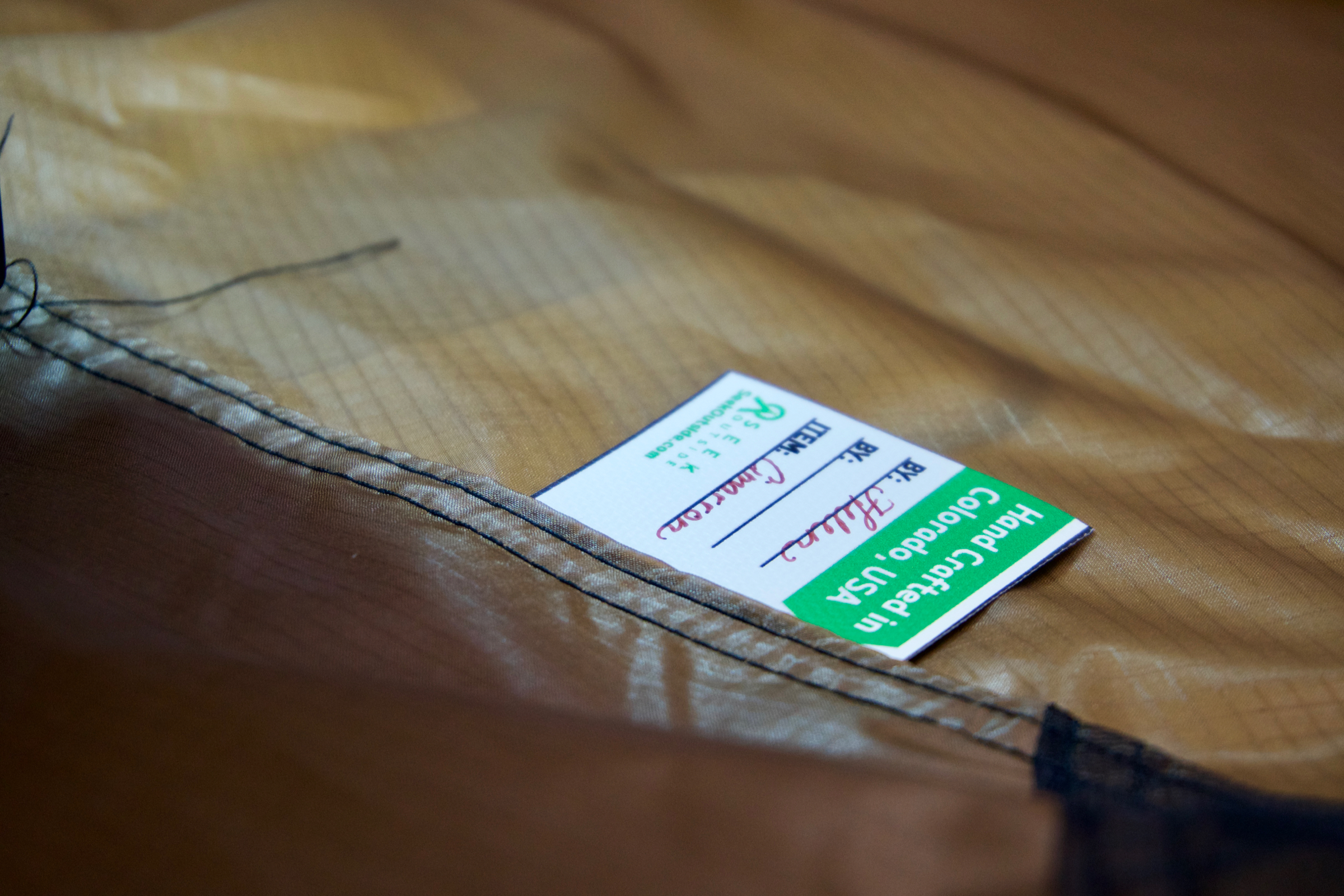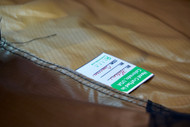Tent Fabrics: A Comparison of Fabric Types
Posted by on 12th Jun 2019
"There are so many tent fabrics...what are the differences, which is best, and why?"
These are questions we get asked often, and it's a reasonable question considering the desired lifespan and expected hard usage that backpacking tents see.
At Seek Outside we take fabric seriously, while knowing that intended use, construction, and design also play key roles in performance. A great fabric in a poor design will never live up to its' potential.
This post will be a deep dive into the most commonly used fabrics for backpacking tents. We will not directly compare to other manufacturers, rather focusing on best fits for uses, and providing facts to educate all tent consumers.

Why isn't tent fabric both waterproof and breathable?
Well, we would love a strong, light, fairly priced waterproof / breathable hot tent fabric. However, this is about as likely to happen as you bringing home a live Unicorn for a kids birthday.
There are various reasons. First, many fabric manufacturers will not sell waterproof / breathable fabrics for use in tents (a bivy being the exception). Second, what makes it waterproof and breathable usually makes it heavier and weaker. Third, the cost of these fabrics is very high, and a comfortably sized winter camping hot tent uses a LOT of fabric, which would drastically increase the cost. If a top end waterproof breathable jacket costs a few hundred dollars, imagine the cost of a tent.
In the end, it's easier, lighter and less expensive to do things the way they have been done which is single wall or double wall tent designs with good ventilation. If properly ventilated, then waterproof / breathable fabric is obsoleted due to cost.
Quick Takeaway:
Waterproof / Breathable fabrics are unlikely to gain traction in tents for a myriad of reasons.
What is Fabric Denier?
Fabric Denier was originally a rating for how thick a fabric was in comparison to a single strand of silk (which was 1 denier and weighed one gram for 9000 Meters of thread. Over time, this has morphed and meanings may be mixed a bit however in general it is a rating of how thick a fabric is. Thus a 30 Denier fabric is thicker than a 20 denier. Heavier denier fabrics are often thought to be stronger and tougher but the toughness can be misleading because a lot of the toughness is determined by other details such as the type of thread / yarn used.
Heavier denier fabrics do weigh more but heavier does not necessarily mean better quality or more durable. In our experience, fabrics below a high quality 30 Denier start to become pretty whispy and likely not suitable for sustained hard use. In addition, the lower denier fabrics do not start to save much weight for example a 7 Denier Nylon weighs more than half what a 30 Denier Nylon does.
Quick Takeaway:
Heavier Deniers are stronger if everything else is equal. Below 30 Denier, the weight saved is not that much in relation to denier.
What is the difference in Nylon and Polyester?
These are both synthetic fabrics, and polyester does have some subtle advantages in UV performance but Nylon is ounce for ounce tougher. Therefore a shelter made of Nylon can be lighter than one made of Polyester. Nylon is also more supple and packs smaller. Polyester is usually a lot cheaper and more common in lower end products.
Quick Takeaway:
Nylon is Stronger than Polyester. Polyester is cheaper and generally heavier.
What is ripstop fabric and is it an advantage?
Ripstop is a reinforcement pattern in the fabrics that adds extra strength to help stop tears from propagating thus "ripstop".
Ripstop is used in better products however there are some cheap fabrics that "look" like ripstop so buyer beware. The knock offs are probably worse than no ripstop at all because they give the illusion of quality or ruggedness.
In the real world, where this will show up in a tent is if you get a hole or slight tear in the fabric. This can happen for many reasons like a branch falling, an excited dog, a bear..... the ripstop is supposed to stop the tear from ripping further (think ripping a sheet).
A non ripstop fabric, or a cheap ripstop knock off will just tear. This is not something you want happening on an extended trip.
Quick Takeaway:
A good ripstop adds strength but beware of knock offs.
What are the different types of Nylon like Nylon 6 or Nylon 6.6 ?
Basically there is Nylon 6, Nylon 6.6 , Robic Nylon and Cordura Nylon which is a nylon 6.6 "high tenacity nylon". Nylon 6 is the least expensive and weakest but still stronger than Polyester. Robic nylon is an improvement in strength and abrasion but it is still not as good as nylon 6.6. Nylon 6.6 is considered "high tenacity nylon" and offers far better strength and tear resistance than Nylon 6.
Cordura Nylon (based on nylon 6.6) in our usage and testing performs a bit different than Nylon 6.6. The differences are subtle and are in how they tear. In our opinion, Cordura Nylon resists tearing better than Nylon 6.6. We suspect the difference is that Cordura looks like it uses an overlapped long fiber where some of the generic nylon 6.6 seem to tear far more cleanly when forced. For us, we decide to use fabric from a trusted source like Cordura with a long track record of durable fabrics.
Takeaway:
Cordura or Nylon 6.6 are both High Tenacity Nylons that are stronger than the rest. We choose to use Cordura due to their long standing reputation for quality.
How do waterproof fabric coatings work like PU and Silicone ?
Most backpacking tent fabrics are Silicone or PU, or a blend of both.
PU (Polyurethane) coating is common, and has been used a long time. This is a heavier coating and PU coatings actually weaken the fabric so they tear more easily. PU also hydrolyzes over time, which causes a foul odor and peeling of the waterproof coating. If you've ever taken a tent out of the closet after long storage and noticed a bad smell, this is what happened.
Silicone coatings on the other hand strengthen the fabrics they are applied to, so they make the fabric harder to rip or tear. Silicone coatings also do not hydrolyze, and are more durable than PU coatings.
A third category are blend coatings, where a bit of PU is mixed into a Silicone coating on one or both sides of the fabric. The advantages here are various, but the main reason we prefer these coatings is decreased tackiness which is desirable in sandy environments. Our Nylon shelters use either a pure silicone or a silicone PU blend.
Put in real world terms, I doubt most users would notice a difference between straight silicone coating and Sil/PU blend coatings, and in many cases a person could argue the the blend may be a better coating despite not being quite as strong. However, at the more extreme range of performance the pure silicone coating will result in a moderately stronger fabric.
From a manufacturing perspective, PU coatings can be seam taped while silicone coatings require seam sealing. This drives the cost of PU fabrics down further compared to silicone.
Quick Takeaway:
A silicone or silicone blend coating creates a stronger lighter fabric than a PU coated fabric.
What is Dyneema or Cuben Fiber?
When talking materials commonly used for tents, Dyneema will offer the best strength to weight - and likely the highest cost. Dyneema is incredibly strong for it's weight and the tent material is basically a ripstop pattern of dyneema fibers sandwiched between mylar film layers.
Dyneema is incredibly waterproof due to the impermeable laminated layers, and has an out of this world strength to weight ratio. It also has zero stretch, which makes it easy to get a good tight pitch, but will also stress stakes, stake loops, and poles more than a silnylon in heavy wind due to the shock absorbing stretch that silnylon has.
Dyneema has a lower melting point than silnylon, so in a hot tent application ember holes will be bigger. We recommend a longer stove pipe for dyneema tents to combat this. On the plus side, dyneema is easier to patch than silnylon, so if you do get a hole or tear it is easy and quick to use a mylar tape to patch it, and the tape is a permanent fix.
Quick Takeaway:
No fabric will provide the strength to weight of dyneema however it will lighten your wallet a fair amount to.
How does UV effect these fabrics?
This is complex, UV really does not effect Dyneema fabrics. UV does impact nylon fabrics however color is very very important. Bright nylon colors like pink, yellow etc can degrade very quickly in high UV environments. However, muted colors like our green, or brown or gray are not impacted near as much. The difference in color is substantial.
Quick Takeaway:
Color matters a lot. Muted colors are far less impacted.
Summary:
Nylon is stronger than polyester, and nylon 6.6 is stronger than nylon 6. Several coatings exist, but at the top end a silicone coating will be the strongest followed by a silicone blend. The weakest will be a PU coating. Put simply, when you are depending on your tent for shelter, in remote places, or in extended severe weather these are the attributes to look for. When you are looking for the combination, of light , small pack size , and strong look at these fabrics.
Here is a quick video comparison
…